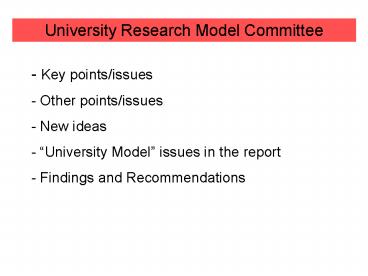University Research Model Committee - PowerPoint PPT Presentation
1 / 13
Title:
University Research Model Committee
Description:
... data/analysis centers ... computing efforts of Tier 2 centers and the Fermilab LPC seem ... E.g. Centers of specific physics/detector expertise? Findings and ... – PowerPoint PPT presentation
Number of Views:24
Avg rating:3.0/5.0
Title: University Research Model Committee
1
University Research Model Committee
- Key points/issues
- Other points/issues
- New ideas
- University Model issues in the report
- Findings and Recommendations
2
University Model - key points/issues
The model has already changed! Old/base
faculty (summer) students postdoc(s) with
flat or slow growth but still valid and in need
of support. New project funding, e.g. ATLAS
CMS project funding is on same scale as whole
university program. The project funding can last
several (many?) years, but is transient. Is this
the new model we want (LHCILC?). We have
discussed erosion of base support, erosion of
infrastructure, problems with ILC RD funding,
need for more phenomenologists, etc.
3
University Model - key points/issues
- Fixing any or all of these problems within the
context of a flat (or worse) budget implies
realignment of funds. - - Simply recommending an increase in funding for
HEP has been tried several times by other groups
(Gilman 98, Treiman 88) with limited success.
We have to focus on how to best use the existing
funding resources, while taking into account the
fluidity of the project funds. - This requires looking at the field as a whole in
order to be able to suggest changes in the
University Program extends scope of this group! - - Winding down current U.S.-based accelerator
program/changing nature of Labs -gt opportunity.
4
University Model - key points/issues
- Erosion of infrastructure fewer groups
involved in detector work. Should we recommend a
specific program to re-establish university
infrastructure and/or a dedicated source of
support? Should this be generic or only tied to
specific need? - ILC in the U.S. must act NOW to improve
participation in detector RD! - Large number of HEP groups strength in
diversity of people/ideas vs. funding spread
thin. Efficiency? Do we need to justify the size
of the program vs. activity? Ensuring support for
the individual(s) with a bright idea. - - Self organization e.g. Tier 2 computing
centers for LHC extend to multi-group
collaborative efforts.
5
Other points/issues
- Base vs. project funding. Is there a better way
to organize this or is this an inevitable feature
of the present model? Concern over lack of review
of allocation of project funds. - Relation of theory and experiment need for
expanded phenomenology program. Distribution of
people? - Planning changes before we know the LHC results.
HEP phase change driven by LHC results?
6
New ideas
- Talked to many peoplecommon sense of this
exercise being an opportunity to change the
model. - However, on reflection, the present basic model
seems to work well and should be supported and
strengthened. - Possible changes considered
- - Fewer groups more efficient
program? - - Handing greater
educational/training roles to national labs. - - Forming more data/analysis
centers - - Certainly need better ways to work remotely
true internationally, but also beneficial
intra-nationally.
7
New ideas
- - Expanded support for university program from
program(s) ending at lab(s) vs. sustaining size
of lab programs overall. - Targeted revitalization of university
infrastructure, and strengthening of base program
using realigned funds. - The focused physics/computing efforts of Tier 2
centers and the Fermilab LPC seem to be starting
to work well. Should we encourage more such
enterprises, perhaps with funding specifically
designated for their support? E.g. Centers of
specific physics/detector expertise?
8
Findings and recommendations
Findings
- The existing (old) model of a university HEP
group is still valid and essential to maintain
the creativity and diversity of the field. - Erosion of base support for people and
infrastructure has limited the effectiveness of
university groups. - Project funding is playing an increasing role in
the support of university groups. However, it is
managed rather than being pier reviewed. - Previous recommendations for funding increases
have met with limited success. A new approach is
needed.
9
Findings and recommendations
Findings (cont.)
5) There is a need to have more phenomenologists
working in university groups, particularly for
analysis and interpretation of imminent LHC
data. 6) The self-organization of groups in
relation to e.g. Tier 2 LHC computing centers is
a useful concept and appears to be working.
10
Findings and recommendations
Recommendations
- The university base program and university HEP
infrastructure should be strengthened. - Part of the funding to be released by the ending
of the Tevatron and Babar programs should be used
to strengthen the university base program and its
infrastructure. - The strengthened university base program should
include an increased number of phenomenologists
to work with experimentalists on data analysis
and interpretation.
11
Findings and recommendations
Recommendations (cont.)
4) Further self-organization of university (and
lab) groups in terms of computing and analysis
centers should be encouraged and supported.
12
University Model issues in the report
- University program contributions scope,
quality, relevance is the size of the present
program well matched to the scope? Do we need to
re-scope? How could the quality be enhanced? - University program manpower, resources,
infrastructure realignment of support seems to
be the only way to address deficiencies in these
areas. Quantitative how much realignment is
needed?
13
University Model issues in the report
- Funding Model and program management
recommending an increase in support is obvious
realignment of support may be more realistic. How
do we achieve a consensus in the U.S. HEP
community on this issue? - Enhancing the University role all of the above!































